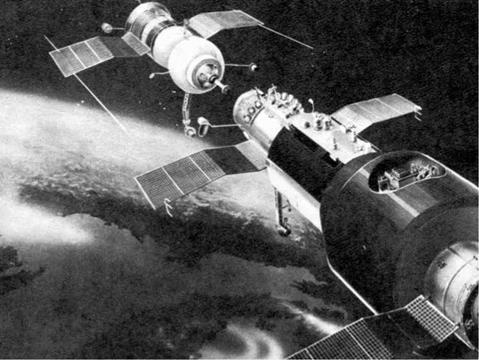A REAL ALTERNATIVE: SPACE STATIONS
The government decision of 8th January 1969 to reorientate the space programme around unmanned lunar exploration and space stations did lead to a successful
|
Salyut – an alternative programme |
programme of unmanned lunar exploration (Chapter 7: Samplers, rovers and orbiters). More important in the long term, it propelled the Soviet Union into becoming the leading country in the development of space stations. In January 1969, at the reception for the Soyuz 4-5 cosmonauts, Mstislav Keldysh had announced that space stations would be the main line of development of the programme. In October 1969, advocates of the programme cunningly slipped into a speech by Leonid Brezhnev the declaration that they were now the main line of development.
Space stations had always featured in Soviet space thinking, back to the time of Tsiolkovsky. Korolev had brought forward outline designs of a manned space station in the early 1950s, to be launched by his N-1 rocket. The first space station programme to win approval for development was a proposal put forward by Vladimir Chelomei’s OKB-52 and approved as the Almaz military space station programme (1964). This complex design made slow progress and by 1969 was still some two or three years distant. Accordingly, the decision was taken in early 1970 to combine the Almaz design of OKB-52 with Soyuz hardware developed by OKB-1 so as to construct a space station as soon as possible. Despite these hasty and makeshift origins, not to mention Chelomei’s opposition, the space station was actually built quite quickly, in only a year. It was launched in 1971 as Salyut and duly became the first manned orbiting space station, a full two years before America’s Skylab. As the moon programme encountered ever more difficulties, the Russians gave their space station programme ever more retrospective justification.
The Soviet Union’s space station programme in the early to mid-1970s was cursed with difficulties, and these certainly contributed to Mishin’s downfall as much as the moon race. The first crew to reach Salyut was able to link to the station, but not dock properly or enter the station and had to make an emergency return. In the worst-ever disaster to affect the manned programme, the three cosmonauts who flew to Salyut in June 1971 perished on their return, when a depressurization valve opened at high altitude. The next Salyut crashed on launch in July 1972.
The racing days of the moon programme echoed again in spring 1973 as the Americans at last prepared to launch their space station, Skylab. To match Skylab, the Russians prepared two space stations for launch, planning to have both of them operational and occupied at the same time. The first, which was also the first Almaz station, suffered an on-orbit engine explosion and had to be abandoned before it was manned. The second accidentally exhausted all its fuel on its first orbit and also had to be abandoned. It must have galled the Russians that America’s Skylab then went on to become such a stunning success.
The first successful space station occupation did not take place until July 1974, when Pavel Popovich and Yuri Artyukin occupied the second Almaz station. This was the first flight after the dismissal of Mishin and the first to take place on Glushko’s watch. Even then, the space station programme was to suffer many setbacks and disappointments. Soyuz 15, 23 and 25 had to come down early when their docking manoeuvres failed. The space station programme did not reach maturity until Salyut 6 (occupied 1977-82) and 7 (occupied 1982-6). Here, Soviet cosmonauts learned to live in space, pushing back the frontiers of long-distance flight to 96,139,175,185,211 and 237 days. Salyuts received regular visitors: unmanned refuelling craft and visiting missions from the socialist countries. With Mir (occupied 1986-2000), the Soviet Union built a permanent orbital station. Mir became to the Soviet programme what Apollo had been to the Americans. Only by returning to its roots in the writings of Tsiolkovsky and the other early visionaries did the programme at last find its true vocation.











